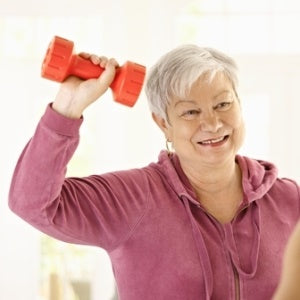Here are some simple exercises and vitamins to help you improve your posture.
"It's very important for us to be able to stretch and open up and improve our range of motion now that many of us spend our days hunched in front of a computer," said Jonathan F. Bean, MD, MS, MPH, an assistant professor in the department of physical medicine and rehabilitation at Harvard Medical School in Boston.
According to the NLM, we lose bone mass or density as we age. Calcium and other minerals are lost from the bones. The vertebrae (or spine bones) lose some mineral content, making each bone thinner. The gel-like cushions between the vertebrae (known as disks) lose fluid and become thin. The spinal column curves and compresses (packed together). Age-related bone spurs and general utilization of the spine may also form on the vertebrae.
It is especially crucial as you become older to develop daily habits that will help you improve your posture.
To stay limber, get up every half hour and stretch, walk, or stand for a few minutes.
Here are some more techniques to keep and even enhance your posture.
Any exercise may help improve your posture, according to the National Library of Medicine (NLM), but workouts that strengthen your core (muscles surrounding your back, belly, and pelvis) are the best.
The plank is one of the best exercises for core strength. This is how you do it: Lie facedown with your legs outstretched and your elbows directly beneath your shoulders. Position your palms flat on the floor, feet hip-width apart, and elbows shoulder-width apart. Tuck your toes and engage your abs to elevate your body (forearms remain on the ground). From your shoulders to your heels, you should form a straight line. Maintain the posture for 30 to 60 seconds.
You can also experiment with different versions, such as a one-arm plank or a high plank. Start carefully with any new workout and stop if you get severe pain.
02/08 Sit Up Straight
"Sitting up with good, tall posture with your shoulders down is a fantastic habit to get into when you have to work at a desk," Rebecca Seguin, PhD, a public health scientist and nutritionist at Texas A&M University, told Health.
This can be difficult to adjust to. Pilates and yoga, which focus on body awareness, can help you sit straighter, according to Dr. Seguin.
Improve Your Core Strength
The diaphragm, abdominal and oblique muscles, paraspinal and gluteal muscles, and pelvic floor comprise the "core."
These muscles have a corset-like effect on the trunk and spine, stabilizing it. Maintaining adequate muscular balance necessitates a strong and effective core.
Protect Your Spine
According to Dr. Bean, if you have menopause, you may have more weakening in the muscles around your spine than someone who does not have menopause.
Menopausal hormone changes cause muscle and bone tissue loss, according to a 2022 study published in the Journal of Cachexia, Sarcopenia, and Muscle. The authors of the study conclude that menopause-related hormonal changes can predispose persons to muscular atrophy and osteoporosis, which can lead to mobility handicap and fall-related fractures later in life.
Weight Training
The bone-thinning disease osteoporosis causes spinal compression fractures, which reduce our height and can contribute to the "dowager's hump" in the upper back that is a trademark of old age. The most common bone illness is osteoporosis, which is characterized by weakened bone tissue, bone structure, and strength. According to the Centers for Disease Control and Prevention, it may increase the risk of fractures (CDC).
Weight-bearing exercises such as walking, stair climbing, and weight lifting can help people avoid these alterations.
Vitamin D
Vitamin D is vital for bone health and muscular health, according to the National Institutes of Health (NIH). To help maintain strong bones and avoid osteoporosis, it's better to acquire vitamin D (and calcium) through food. According to the NIH, most people obtain enough vitamin D from food and sunlight without needing supplements. Taking vitamin D and calcium supplements enhances bone strength marginally in older persons, but it's unclear whether they lessen the chance of falling or fracturing a bone.
The NIH recommends 600 IU of vitamin D per day for adults under the age of 70 and 800 IU for adults over the age of 70.
Consume Healthy Food
We've all heard about calcium's bone-building properties. Adults aged 19 to 50, and adult men aged 51 to 70, should consume 1,000 milligrams of calcium each day, according to the NIH. Women over the age of 50, as well as all people aged 71 and up, should consume 1,200 milligrams every day.
Many foods contain calcium. The NIH recommends eating milk, yogurt, cheese, canned sardines, salmon, vegetables (such as kale, broccoli, and Chinese cabbage), and most cereals to get the appropriate amount of calcium.
Calcium, like vitamin D, may be better obtained through diet rather than pills.
Consult your doctor to determine whether you need to take calcium supplements.



